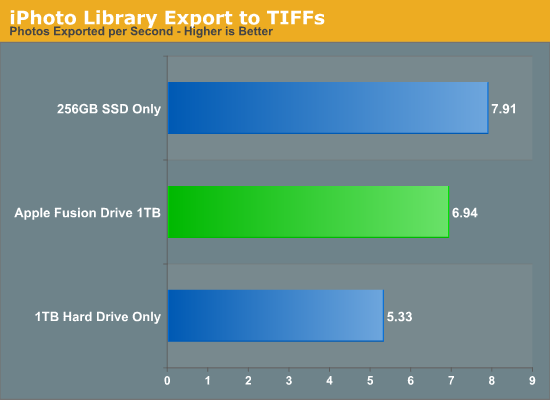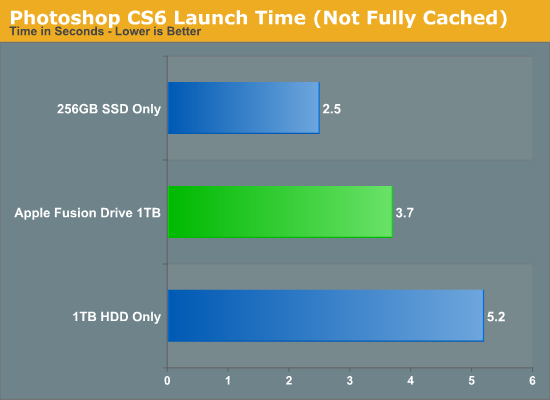A Month with Apple's Fusion Drive
by Anand Lal Shimpi on January 18, 2013 9:30 AM EST- Posted in
- Storage
- Mac
- SSDs
- Apple
- SSD Caching
- Fusion Drive
Putting Fusion Drive’s Performance in Perspective
Benchmarking Fusion Drive is a bit of a challenge since it prioritizes the SSD for all incoming writes. If you don’t fill the Fusion Drive up, you can write tons of data to the drive and it’ll all hit the SSD. If you do fill the drive up and test with a dataset < 4GB, then you’ll once again just measure SSD performance.
In trying to come up with a use case that spanned both drives I stumbled upon a relatively simple one. By now my Fusion Drive was over 70% full, which meant the SSD was running as close to capacity as possible (save its 4GB buffer). I took my iPhoto library with 703 photos and simply exported all photos as TIFFs. The resulting files were big enough that by the time I hit photo 297, the 4GB write buffer on the SSD was full and all subsequent exported photos were directed to the HDD instead. I timed the process, then compared it to results from a HDD partition on the iMac as well as compared to a Samsung PM830 SSD connected via USB 3.0 to simulate a pure SSD configuration. The results are a bit biased in favor of the HDD-only configuration since the writes are mostly sequential:

The breakdown accurately sums up my Fusion Drive experience: nearly half-way between a hard drive and a pure SSD configuration. In this particular test the gains don't appear all that dramatic, but again that's mostly because we're looking at relatively low queue depth sequential transfers. The FD/HDD gap would grow for less sequential workloads. Unfortunately, I couldn't find a good application use case to generate 4GB+ of pseudo-random data in a repeatable enough fashion to benchmark.
If I hammered on the Fusion Drive enough, with constant very large sequential writes (up to 260GB for a single file) I could back the drive into a corner where it would no longer migrate data to the SSD without a reboot (woohoo, I sort of broke it!). I suspect this is a bug that isn't triggered through normal automated testing (for obvious reasons), but it did create an interesting situation that I could exploit for testing purposes.
Although launching any of the iMac's pre-installed applications frequently used by me proved that they were still located on the SSD, this wasn't true for some of the late comers. In particular, Photoshop CS6 remained partially on the SSD and partially on the HDD. It ended up being a good benchmark for pseudo-random read performance on Fusion Drive where the workload is too big (or in this case, artificially divided) to fit on the SSD partition alone. I measured Photoshop launch time on the Fusion Drive, a HDD-only partition and on a PM830 connected via USB 3.0. The results, once again, mirrored my experience with the setup:

Fusion Drive delivers a noticeable improvement over the HDD-only configuration, speeding up launch time by around 40%. A SSD-only configuration however cuts launch time in more than half. Note that if Photoshop were among the most frequently used applications, it would get moved over to the SSD exclusively and deliver performance indistinguishable from a pure SSD configuration. In this case, it hadn't because my 1.1TB Fusion Drive was nearly 80% full, which brings me to a point I made earlier:
The Practical Limits of Fusion Drive
Apple's Fusion Drive is very aggressive at writing to the SSD, however the more data you have the more conservative the algorithm seems to become. This isn't really shocking, but it's worth pointing out that at a lower total drive utilization the SSD became home to virtually everything I needed, but as soon as my application needs outgrew what FD could easily accommodate the platform became a lot pickier about what would get moved onto the SSD. This is very important to keep in mind. If 128GB of storage isn’t enough for all of your frequently used applications, data and OS to begin with, you’re going to have a distinctly more HDD-like experience with Fusion Drive. To simulate/prove this I took my 200GB+ MacBook Pro image and moved it over to the iMac. Note that most of this 200GB was applications and data that I actually used regularly.
By the end of my testing experience, I was firmly in the category where I needed more solid state storage. Spotlight searches took longer than on a pure SSD configuration, not all application launches were instant, adding photos to iPhoto from Safari took longer, etc... Fusion Drive may be good, but it's not magic. If you realistically need more than 128GB of solid state storage, Fusion Drive isn't for you.










127 Comments
View All Comments
edlee - Friday, January 18, 2013 - link
I get the cached solution for fusion. But I would rather just handle the usage myself and have os and applications on SSD and all media on a Raid array.SSD for life.
Death666Angel - Friday, January 18, 2013 - link
It looks better than I thought. I'm still not going to use it myself (Windows/Linux user here and I have no trouble managing more than one partition). But it seems better than the usual Windows caching solutions. Still, the non-technical people I know don't need more than a few hundred GB of space on their PC and no one has more than one HDD in their PC anyway. So the easiest way for them (which is what I always recommend) is to have a 256GB SSD and an external 1 to 3TB drive. All their work is on the SSD with daily/weekly backups and photos are on their external HDD (none of those people use the PC to view movies).tipoo - Friday, January 18, 2013 - link
If you write a huge file, it all gets written to the SSD up to 117GB. But that SSD is filled with other stuff. Won't it be limited by the speed it transfers the old things to the hard drive? How does that work if the files aren't mirrored?name99 - Friday, January 18, 2013 - link
Read the damn article before posting. ALL those questions are answered there.ltcommanderdata - Friday, January 18, 2013 - link
Apple still lists the 3TB Fusion drive as incompatible with Boot Camp "at this time". Presumably this is due to how Apple is doing the BIOS emulation with EFI 1.10 and running into the 2.2TB drive size limit. Have you heard any methods to get 3TB Fusion working with Boot Camp or heard whether Apple has a solution in the works?tipoo - Friday, January 18, 2013 - link
Just curious, I think that's how Readyboost worked. You would have a flash drive immediately start sending data slowly to your computer while the hard drive took its time to seek the larger chunks of data. So I wonder if there is a large queue of data for a Fusion drive to read, it will read from both drives concurrently?tipoo - Friday, January 18, 2013 - link
"In less than a year Apple could double the size of the NAND used in Fusion Drive at no real change to cost."But will they? If the iPods, iPhones, and iPad are any indication, they will more likely pocket the savings. Been a long time since a capacity doubling from them.
name99 - Friday, January 18, 2013 - link
Oh for fscks sake.The iPod nano1 came in sizes of 1, 2, 4GB
The 2nd gen came as 2, 4, 8GB.
3rd were 4, 8GB
4th was 4,8, 16GB.
All at essentially the same retail price.
Apple has showed consistent pattern (you also see it in the shuffle, or in iPod Touch), of doubling the storage until they hit a point which seems to cover almost everyone's needs. Then there is a year or two of stasis, then a new product category which requires more storage.
Next time you want to post blatant nonsense, try to remember that on the internet people WILL call you out when you state bullshit.
tipoo - Friday, January 18, 2013 - link
Feeling self-important today? Yes, that's what I mean, there hasn't been a doubling since the fourth generation Nano. Or does "Been a long time since a capacity doubling from them" mean "they have never ever doubled capacity" in your little world?tipoo - Friday, January 18, 2013 - link
"Then there is a year or two of stasis, then a new product category which requires more storage."Like the iPads, which would be ideal for storing HD video if not for the exorbitant prices of higher capacities, with zero bump for the base price since the first one?